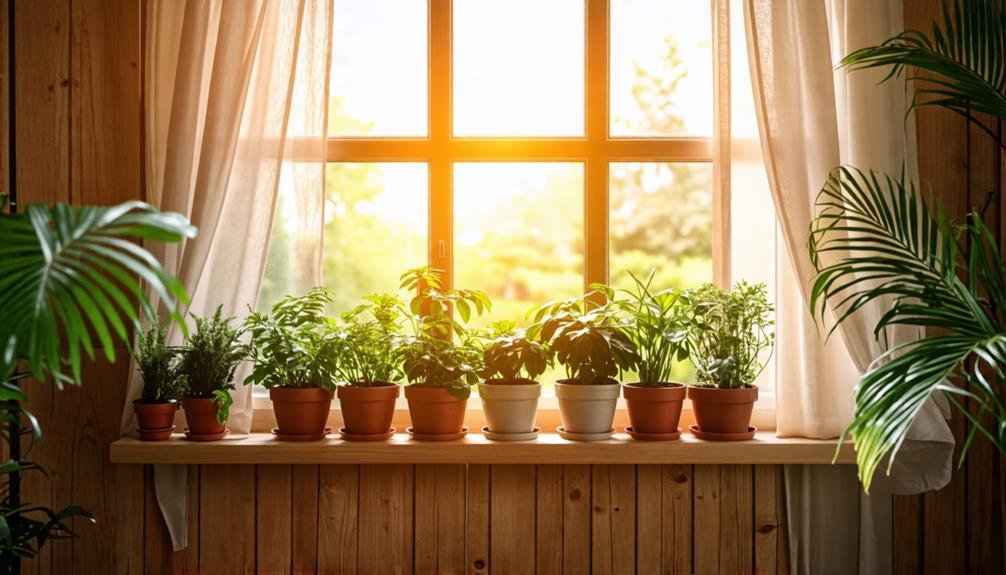To attract hummingbirds with a miniature garden window planter box, start by selecting the right planter that fits your window dimensions and beautifies your home's exterior. Use vibrant, nectar-rich plants like Salvia, Fuchsia, and Petunia, which flower throughout the summer. Make sure the plants are grouped together for maximum visibility and positioned in areas with ample sunlight. Regular maintenance, including deadheading and checking for pests, is crucial for plant health. Furthermore, protect your garden from extreme weather by using appropriate materials and potting mixes. This approach not only beautifies your space but also invites delightful hummingbirds to visit. Explore more strategies to enrich this experience.
Selecting the Right Window Box
When selecting the right window box, it's essential to consider the dimensions of your window and the style of your home's exterior for a cohesive look. A well-chosen window planter can enhance your home's curb appeal and create an ideal environment for a small garden. Start by measuring the width of your window and take into account how the planter will fit with existing features, such as decorative shutters or roof overhangs.
The material and color of the window box should harmonize with your home's design. For instance, wooden planters from brands like CedarCraft provide a rustic charm, while metal options from companies such as Bloem can offer a sleek, modern touch.
Additionally, consider how the selected box will support your favorite garden decorations. The size of the planter should not only encourage healthy plant growth but also ensure adequate drainage, which is crucial for maintaining plant vitality.
Ultimately, the right window planter box will serve both functional and aesthetic purposes, acting as an attractive focal point that creates a welcoming atmosphere for residents and visitors alike. By thoughtfully selecting your window box, you can nurture a flourishing small garden that enhances your outdoor space.
Installing Your Window Planter
Installing your window planter begins with accurately measuring the dimensions to guarantee a proper fit. It is crucial to secure the planter using sturdy installation methods, such as bolts or brackets, to provide sufficient support for its weight. By taking these steps, you can create a stable and appealing addition to your window space.
Measuring the Window Box
Measuring your window box accurately is essential for ensuring a precise fit with your window dimensions and nearby features. Start by measuring the length of your window. To create a cohesive appearance, think about how the box will interact with elements like shutters or window trim. Select a box that is slightly narrower than the window width for visual harmony.
Next, evaluate the depth and height of the window box. A depth of 6 to 8 inches is typically ideal, providing ample space for soil and plant roots. Ensure that the height complements your window while allowing sufficient room for flowers that attract hummingbirds. This choice enhances your garden's visual appeal and creates a lively display.
Securing Installation Methods
After measuring the dimensions of your window box, the next step is to secure it to ensure stability and safety during use. First, choose appropriate installation hardware, like heavy-duty brackets or stainless steel bolts, which can support the weight of the planter. If your window box is mounted on a wooden surface, it's essential to drill screws into wall studs for a strong anchor. This technique guarantees that the box remains stable against wind and other external forces.
For brick or masonry exteriors, use masonry anchors to achieve a firm fit. These anchors prevent movement and protect both the planter and the window. During installation, pay attention to the dimensions of any overlapping elements such as shutters or window casings, ensuring that the box does not obstruct their functionality.
After installation, regularly inspect the hardware and the overall stability of the box. A securely fastened window planter enhances your home's aesthetic appeal and provides a comfortable feeding spot for hummingbirds. With proper installation methods, you can enjoy a thriving miniature garden while ensuring the safety of your vibrant blooms.
Choosing Hummingbird-Friendly Plants

Choosing the right flora is essential for attracting hummingbirds to your window box. These colorful avians are particularly drawn to specific blooms that offer nectar and aesthetic charm. To create a welcoming space, consider adding plants like Salvia, Fuchsia, Petunia, and Lantana. These varieties are especially popular among hummingbirds and thrive in containers.
Select species that flower throughout the summer for a continuous nectar supply. Also, evaluate the sunlight and wind exposure, as window boxes may face harsher conditions than traditional gardens. Focus on plants with vibrant, tubular blooms that are easily accessible to hummingbirds.
Additionally, pay attention to the hydration requirements of these plants; window boxes can dry out rapidly. Opting for drought-resistant species can help manage water retention. By thoughtfully selecting hummingbird-friendly plants, you will enhance the visual appeal of your window box while providing a nurturing environment for these captivating birds, allowing them to thrive in your garden.
Caring for Your Window Box
Caring for your window box requires a consistent approach to watering, fertilizing, and maintaining the plants. Establishing a regular watering routine is essential, as the growing medium can dry out quickly, especially in warm weather. Furthermore, incorporating slow-release fertilizers and practicing pruning and deadheading techniques will support healthy growth and prolonged blooming, ensuring your window box remains vibrant and attractive.
Watering Routine Essentials
Establishing a consistent watering schedule is essential for maintaining the health and vibrancy of the flowers in your window box. The soil can dry out quickly, especially in hot weather, so it's important to regularly check moisture levels. Water your window box frequently, potentially every day, to ensure that the plants receive enough hydration.
When watering, soak the soil thoroughly until moisture seeps through the drainage holes at the bottom of the box. This practice quenches the plants' thirst and encourages healthy root development. Additionally, consider the weather; during particularly hot or windy conditions, your flowers may need more frequent watering.
Fertilizing for Growth
Regular hydration is essential, but to promote vigorous growth and radiant flowers in your planter, establishing a fertilization schedule is crucial. The confined space of a planter can lead to nutrient depletion, making it imperative to replenish these vital components consistently. Utilizing a slow-release fertilizer, like Miracle-Gro or Osmocote, is an effective strategy, as it delivers a continuous supply of nutrients, ensuring your flora thrives.
When selecting fertilizer, opt for a balanced blend, such as 10-10-10 or 14-14-14, which contains equal proportions of nitrogen, phosphorus, and potassium. These essential nutrients enhance overall plant health, fostering lush greenery and plentiful blooms that attract hummingbirds. Apply the fertilizer according to the guidelines provided by the manufacturer, generally every four to six weeks throughout the growing season.
In addition to slow-release varieties, liquid fertilizers like FoxFarm or Dyna-Gro can be employed for a rapid nutrient boost. Dilute the liquid fertilizer in water and administer it biweekly, particularly if your plants exhibit signs of nutrient deficiency, such as chlorosis. By cultivating a regular fertilization routine, you will create an appealing environment that draws hummingbirds while elevating the aesthetic charm of your planter.
Pruning and Deadheading Techniques
To keep your window box flowers healthy and vibrant, using proper pruning and deadheading methods is crucial for encouraging continuous blooms and strong plant vitality. Pruning involves cutting away dead, damaged, or overgrown stems, which promotes fresh growth and enhances air circulation. This practice helps prevent diseases and creates a more attractive arrangement. Use high-quality Fiskars pruning shears for clean, precise cuts, ensuring that adjacent leaves are not harmed.
Deadheading, the technique of removing faded blooms, is equally important. By cutting off these spent flowers, plants do not waste energy on seed production, allowing them to focus on generating new blossoms. This not only enhances the visual charm of your window box but also draws in pollinators like hummingbirds, who are in search of fresh nectar.
As you carry out these maintenance tasks, regularly check your plants for any signs of pests or diseases. Adopting these pruning and deadheading methods will significantly prolong the blooming season of your window box flowers, creating a welcoming environment for hummingbirds and enriching the aesthetic of your miniature garden. With diligent care, your window box can thrive, providing a brilliant display throughout the growing season.
Designing an Attractive Planter

A stunning planter enhances the aesthetic allure of your residence and fosters a vibrant habitat for vivid blossoms that attract hummingbirds. To craft an eye-catching window planter, blend functionality with elegance. Choose a container that complements your home's architecture, opting for materials like cedar wood, galvanized steel, or high-density polyethylene that can endure outdoor elements while elevating your façade.
Dimensions matter; ensure the planter fits your window's proportions without obstructing views or light. Additionally, consider how the planter harmonizes with other architectural features, such as vinyl shutters or wrought iron railings. Utilize heavy-duty brackets or industrial-grade bolts for secure mounting, ensuring stability against gusts and weight.
When selecting flora, opt for species like Salvia splendens and Fuchsia magellanica, which flourish in window boxes and entice hummingbirds with their vivid hues and nectar-rich blossoms. Organize the plants with varying heights and textures to enhance visual interest; position taller species at the back, with cascading varieties at the front.
Protecting Plants From Weather
Resilience in garden design is crucial for protecting window box blooms from erratic weather patterns. Sudden temperature fluctuations, severe storms, and intense sunlight can jeopardize the vitality of your flora. To address these challenges, proactive strategies are essential. Keep an eye on local meteorological updates to predict extreme weather, enabling you to prepare in advance.
When frost threatens, drape your window boxes with lightweight fabric or plastic sheeting for insulation. During scorching heat waves, consider utilizing shade cloths, such as those from Gardener's Supply Company, to shield your blossoms from harsh sunlight, preventing wilting. Additionally, the careful positioning of your window box can significantly enhance plant protection; placing it in a sheltered nook can lessen the effects of wind and heavy rainfall.
Moreover, opting for a high-quality, well-draining potting mix, like Miracle-Gro Potting Mix, will assist your plants in handling excess water during storms, minimizing the risk of root rot. Regularly examine your flowers for signs of distress and adjust their care to support their health. By employing these tactics, you can nurture a flourishing window box garden that stays robust against nature's unpredictable whims.
Enhancing Hummingbird Visits

Creating a thriving habitat for hummingbirds involves selecting vibrant, nectar-rich blossoms that bloom throughout the summer, ensuring a steady food supply for these enchanting pollinators. To enhance hummingbird visits, incorporate a variety of flowers such as Salvia, Fuchsia, and Petunia, which are renowned for their ability to attract these delicate birds. Planting in clusters can create a visually striking display while providing a more enticing feeding area.
Maintaining these plants is crucial; regular watering and fertilization with products like Miracle-Gro will keep them healthy and vibrant. Deadheading spent blooms encourages new growth, extending the blooming period and, consequently, attracting more hummingbirds. Furthermore, consider the placement of your window box. A well-positioned container that receives ample sunlight can significantly increase flower vitality and, in turn, hummingbird activity.



















You must be logged in to post a comment Login